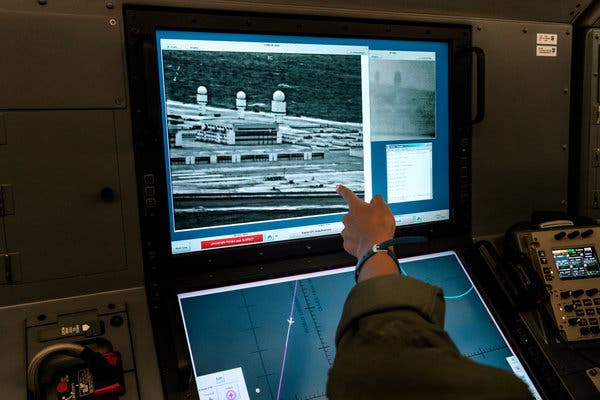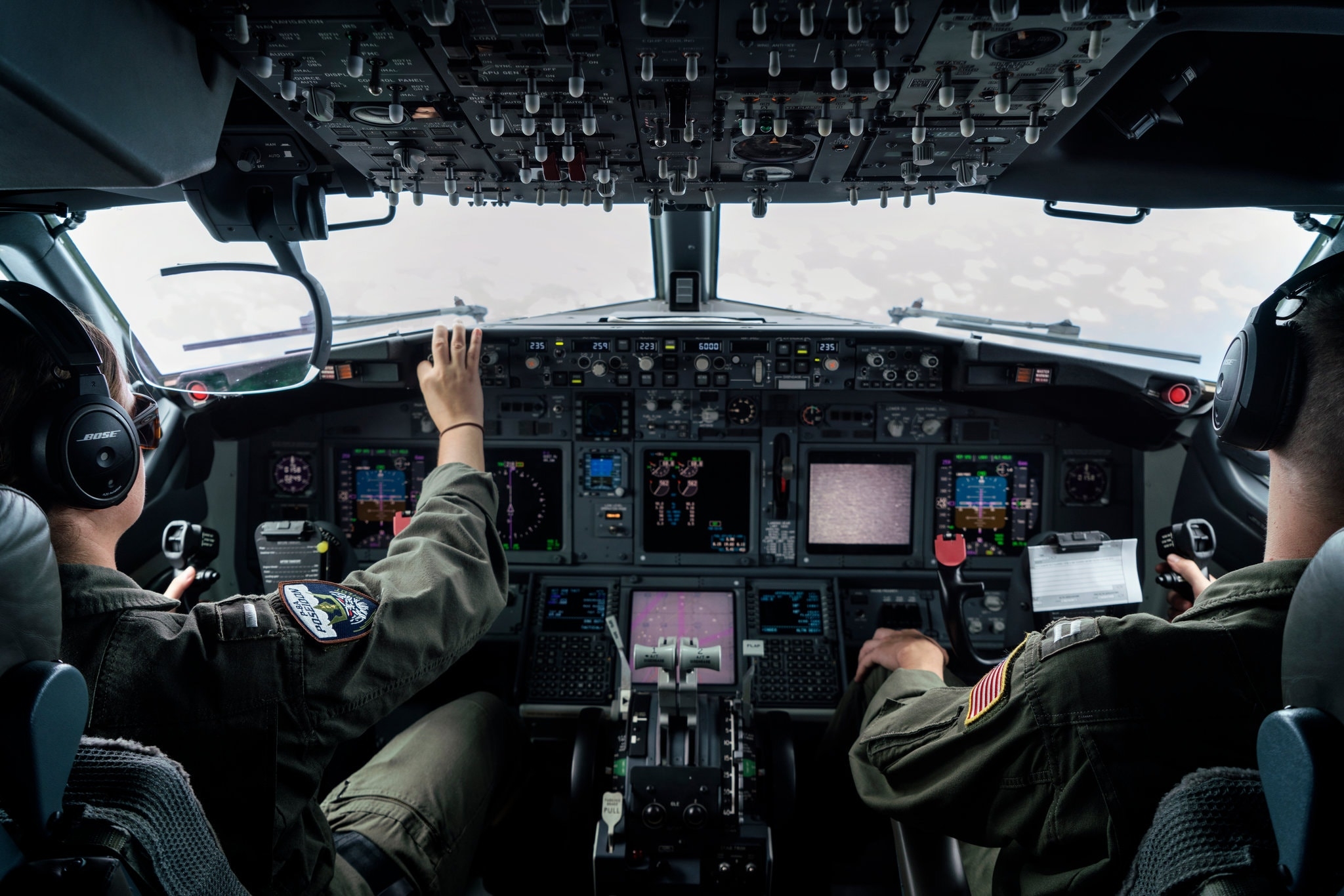https://www.youtube.com/watch?time_continue=2&v=mGb6uRIGpWs&feature=emb_logo
Cmdr. Chris Purcell, the American squadron commander, said such challenges have been routine during the four months he has flown missions over the South China Sea.
“What they want is for us to leave, and then they can say that we left because this is their sovereign territory,” he said. “It’s kind of their way to try to legitimize their claims, but we are clear that we are operating in international airspace and are not doing anything different from what we’ve done for decades.”
In 2015, President Xi stood in the Rose Garden at the White House and promised that “there is no intention to militarize” a collection of disputed reefs in the South China Sea known as the Spratlys.
But since then, Chinese dredgers have poured mountains of sand onto Mischief Reef and six other Chinese-controlled features in the Spratlys. China has added at least 3,200 acres of new land in the area, according to the Asia Maritime Transparency Initiative run by the Center for Strategic and International Studies.
Descending as low as 5,000 feet, the surveillance flight this month gave a bird’s-eye view of the Chinese construction.
On Subi Reef, a construction crane swung into action next to a shelter designed for surface-to-air missiles. There were barracks, bunkers and open hangars. At least 70 vessels, some warships, surrounded the island.
On Fiery Cross Reef, a complex of buildings with Chinese eaves was arrayed at the center of the reclaimed island, including an exhibition-style hall with an undulating roof. It looked like a typical newly built town in interior China — except for the radar domes that protruded like giant golf balls across the reef. A military-grade runway ran the length of the island, and army vehicles trundled across the tarmac. Antenna farms bristled.
“It’s impressive to see the Chinese building, given that this is the middle of the South China Sea and far away from anywhere, but the idea that this isn’t militarized, that’s clearly not the case,” Commander Purcell said. “It’s not hidden or anything. The intention, it’s there plain to see.”
In other spots, reclamation could also be seen on Vietnamese-controlled features, such as West London Reef, where workers dragged equipment past piles of sand. But dredging by Southeast Asian nations is scant compared with the Chinese effort.
In April, China for the first time deployed antiship and antiaircraft missiles on Mischief, Subi and Fiery Cross, American military officials said. The following month, a long-range bomber landed on Woody Island, another contested South China Sea islet.
A Pentagon report released in August said that with forward operating bases on artificial islands in the South China Sea, the People’s Liberation Army was honing its “capability to strike U.S. and allied forces and military bases in the western Pacific Ocean, including Guam.”
In response to the intensifying militarization of the South China Sea, the United States in May disinvited China from joining the biannual Rim of the Pacific naval exercise, the world’s largest maritime warfare training, involving more than 20 navies.
“We are prepared to support China’s choices, if they promote long-term peace and prosperity,” Mr. Mattis said, explaining the snub. “Yet China’s policy in the South China Sea stands in stark contrast to the openness of our strategy.”

Projecting Power
For its part, Beijing claims the United States is the one militarizing the South China Sea. In addition to the routine surveillance flyovers, Mr. Trump has sent American warships more frequently to waters near China’s man-made islands. These so-called freedom of navigation patrols, which occur worldwide, are meant to show the United States’ commitment to maritime free passage, Pentagon officials say.
The last such operation by the United States was in May, when two American warships sailed near the Paracels, another contested South China Sea archipelago. Beijing was irate.
“Certain people in the U.S. are staging a farce of a thief crying, ‘Stop, thief!’ ” said Hua Chunying, a Chinese foreign ministry spokeswoman. “It is self-evident to a keener eye who is militarizing the South China Sea.”
The United States says that it does not take any side in territorial disputes in the South China Sea. On its maps, China uses a so-called nine-dash line to scoop out most of the waterway’s turf as its own. But international legal precedent is not on China’s side when it comes to the dashed demarcation, a version of which was first used in the 1940s.
In 2016, an international tribunal dismissed Beijing’s nine-dash claim, judging that China has no historical rights to the South China Sea. The case was brought by the Philippines after Scarborough Shoal was commandeered by China in 2012, following a tense blockade.
The landmark ruling, however, has had no practical effect. That’s in large part because Rodrigo Duterte, who became president of the Philippines less than a month before the tribunal reached its decision, chose not to press the matter with Beijing. He declared China his new best friend and dismissed the United States as a has-been power.
But last month, Mr. Duterte took Beijing to task when a recording aired on the BBC from another P-8A Poseidon mission over the South China Sea demonstrated that Chinese dispatchers were taking a far more aggressive tone with Philippine aircraft than with American ones.
“I hope China would temper its behavior,” Mr. Duterte said. “You cannot create an island and say the air above it is yours.”

Missed Opportunities
Perceptions of power — and Chinese reactions to these projections — have led some analysts to criticize President Barack Obama as having been too timid in countering China over what Adm. Harry B. Harris Jr., the former head of the United States Pacific Command, memorably called a “great wall of sand” in the South China Sea.
Critics, for instance, have faulted the previous administration for not conducting more frequent freedom of navigation patrols.
“China’s militarization of the South China Sea has been a gradual process, with several phases where alternative actions by the U.S., as well as other countries, could have changed the course of history,” said Alexander Vuving, a professor at the Daniel K. Inouye Asia-Pacific Center for Security Studies in Honolulu.
Chief among these moments, Mr. Vuving said, was China’s takeover of Scarborough Shoal. The United States declined to back up the Philippines, a defense treaty ally, by sending Coast Guard vessels or warships to an area that international law has designated as within the Philippines’ exclusive economic zone.
“Seeing U.S. commitment to its ally, Beijing might not have been as confident as it was with its island-building program,” Mr. Vuving said. “The U.S. failure to support its ally in the Scarborough standoff also demonstrated to people like Duterte that he had no other option than to kowtow to China.”
With most of the Spratly military bases nearing completion by the end of the year, according to Pentagon assessments, the next question is whether — or more likely when — China will begin building on Scarborough. A Chinese base there would put the People’s Liberation Army in easy striking distance of the Philippine capital, Manila.
From the American reconnaissance plane, Scarborough looked like a perfect diving retreat, a lazy triangle of reef sheltering turquoise waters. But Chinese Coast Guard vessels could be seen circling the shoal, and Philippine fishermen have complained about being prevented from accessing their traditional waters.
“Do you see any construction vessels around there?” Lieutenant Coughlin asked.
“Negative, ma’am,” replied Lt. Joshua Grant, as he used a control stick to position the plane’s camera over Scarborough Shoal. “We’ll see if it changes next time.”
https://www.nytimes.com/2018/09/20/world/asia/south-china-sea-navy.html




